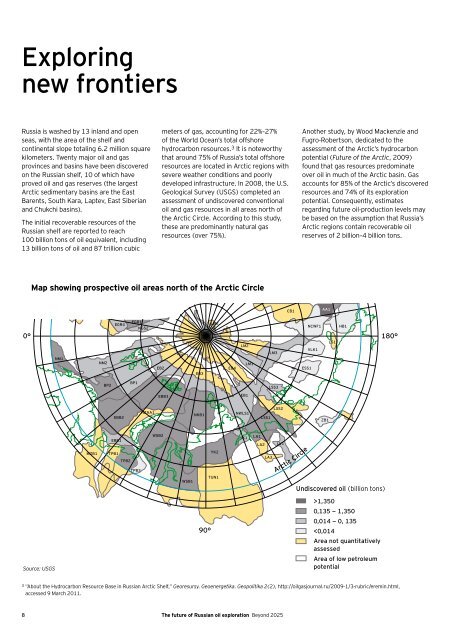The future of Russian oil exploration
The future of Russian oil exploration
The future of Russian oil exploration
You also want an ePaper? Increase the reach of your titles
YUMPU automatically turns print PDFs into web optimized ePapers that Google loves.
Exploring<br />
new frontiers<br />
Russia is washed by 13 inland and open<br />
seas, with the area <strong>of</strong> the shelf and<br />
continental slope totaling 6.2 million square<br />
kilometers. Twenty major <strong>oil</strong> and gas<br />
provinces and basins have been discovered<br />
on the <strong>Russian</strong> shelf, 10 <strong>of</strong> which have<br />
proved <strong>oil</strong> and gas reserves (the largest<br />
Arctic sedimentary basins are the East<br />
Barents, South Kara, Laptev, East Siberian<br />
and Chukchi basins).<br />
<strong>The</strong> initial recoverable resources <strong>of</strong> the<br />
<strong>Russian</strong> shelf are reported to reach<br />
100 billion tons <strong>of</strong> <strong>oil</strong> equivalent, including<br />
13 billion tons <strong>of</strong> <strong>oil</strong> and 87 trillion cubic<br />
0°<br />
NM1<br />
NM2<br />
BP1<br />
meters <strong>of</strong> gas, accounting for 22%–27%<br />
<strong>of</strong> the World Ocean’s total <strong>of</strong>fshore<br />
hydrocarbon resources. 3 It is noteworthy<br />
that around 75% <strong>of</strong> Russia’s total <strong>of</strong>fshore<br />
resources are located in Arctic regions with<br />
severe weather conditions and poorly<br />
developed infrastructure. In 2008, the U.S.<br />
Geological Survey (USGS) completed an<br />
assessment <strong>of</strong> undiscovered conventional<br />
<strong>oil</strong> and gas resources in all areas north <strong>of</strong><br />
the Arctic Circle. According to this study,<br />
these are predominantly natural gas<br />
resources (over 75%).<br />
Map showing prospective <strong>oil</strong> areas north <strong>of</strong> the Arctic Circle<br />
Source: USGS<br />
BP2<br />
EGR4<br />
EBB2<br />
EBB1<br />
MZB1 TPB1<br />
TPB2<br />
EGR1<br />
NGS2<br />
TPB3<br />
NZAA1<br />
8 <strong>The</strong> <strong>future</strong> <strong>of</strong> <strong>Russian</strong> <strong>oil</strong> <strong>exploration</strong> Beyond 2025<br />
EB2<br />
WSB2<br />
EBB3<br />
WSB1<br />
EB3<br />
NKB1<br />
90°<br />
LM2<br />
YK2<br />
TUN1<br />
EB4<br />
LM2<br />
EB1<br />
NWLS1<br />
YK1<br />
LM1<br />
LA1<br />
LSS1<br />
LA2<br />
LA3<br />
LM3<br />
LSS3<br />
LSS2<br />
LV1<br />
CB1<br />
Another study, by Wood Mackenzie and<br />
Fugro-Robertson, dedicated to the<br />
assessment <strong>of</strong> the Arctic’s hydrocarbon<br />
potential (Future <strong>of</strong> the Arctic, 2009)<br />
found that gas resources predominate<br />
over <strong>oil</strong> in much <strong>of</strong> the Arctic basin. Gas<br />
accounts for 85% <strong>of</strong> the Arctic’s discovered<br />
resources and 74% <strong>of</strong> its <strong>exploration</strong><br />
potential. Consequently, estimates<br />
regarding <strong>future</strong> <strong>oil</strong>-production levels may<br />
be based on the assumption that Russia’s<br />
Arctic regions contain recoverable <strong>oil</strong><br />
reserves <strong>of</strong> 2 billion–4 billion tons.<br />
ESS1<br />
Arctic Circle<br />
NCWF1<br />
VLK1<br />
AA1<br />
ZB1<br />
LS1<br />
HB1<br />
Undiscovered <strong>oil</strong> (billion tons)<br />
>1,350<br />
0,135 — 1,350<br />
0,014 — 0, 135<br />


